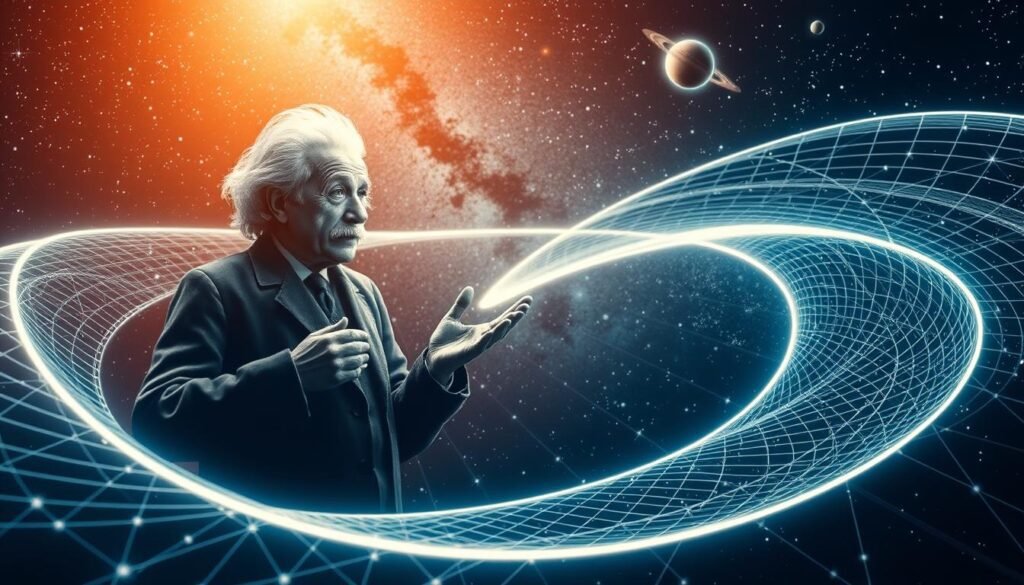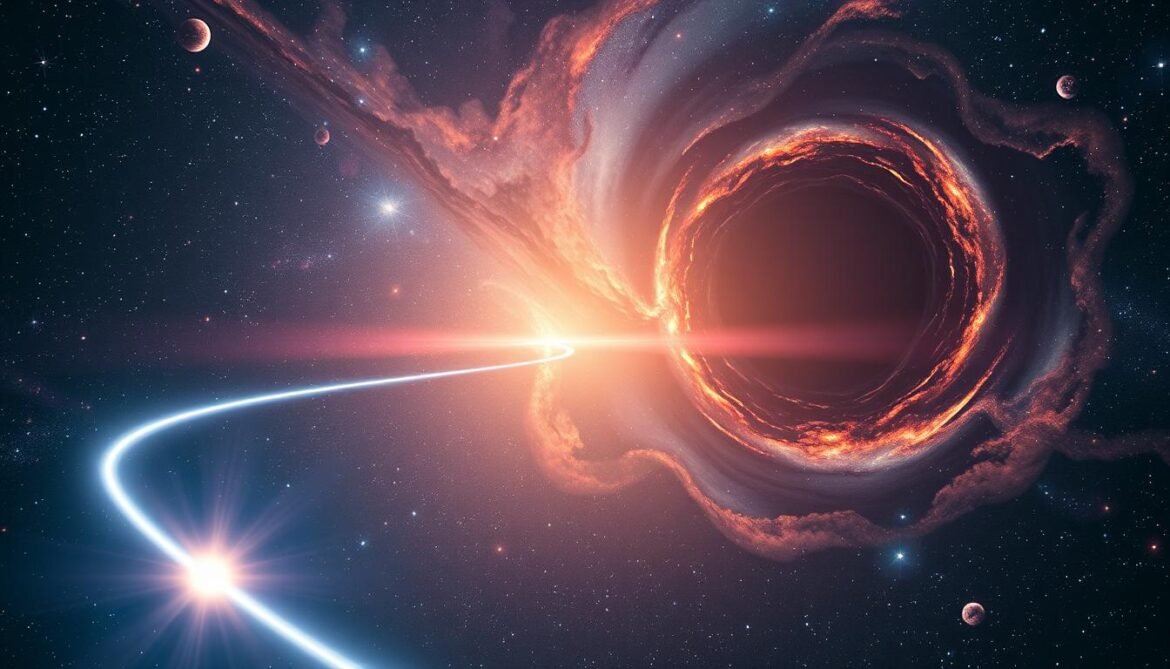Ever thought about why we can’t go faster than light? What secrets does the universe’s speed limit hold? The speed of light is more than a number. It’s a key barrier that shapes our reality.
The speed of light is a constant in our universe, standing at 299,792,458 meters per second. It’s not just a theory but a real limit that affects space and time.
Scientists have always been curious about this limit. Albert Einstein showed that the speed of light is more than a number. It’s a basic part of space-time. When things get close to this speed, strange things happen like time slowing down and objects getting shorter.
Learning about the speed of light is not just physics. It’s about understanding our existence. This limit affects everything from communication to space travel. It’s a big deal in science and technology.
As we explore this topic, we’ll learn why nothing can go faster than this limit. We’ll see how it changes our view of the universe.
Understanding the Concept of Light Speed
Light velocity is a fascinating topic in physics. It shows the fastest speed anything can go in our universe. Electromagnetic waves move at 299,792,458 meters per second in a vacuum. This speed helps us understand how things move in space.

Scientists have always been curious about how light moves. They’ve made many discoveries and done a lot of research to learn about it.
What is the Speed of Light?
The speed of light is the fastest speed for information and energy in space. This constant speed is the same everywhere in the universe. It helps us understand how things interact with each other.
- Exact speed: 299,792,458 meters per second
- Travels through vacuum instantaneously
- Applies to all electromagnetic waves
Historical Context of Light Speed
At first, scientists thought light moved instantly. Ole Rømer changed this idea in the 17th century. He noticed Jupiter’s moon Io to show light’s speed is not infinite.
Mathematical Representation
Physicists use math to talk about light speed. The number 299,792,458 seems random but shows how we measure electromagnetic waves. In natural units, light speed is just 1.
Light speed: A universal constant that defines the limits of our physical reality.
The Significance of the Speed of Light
The speed of light is a key physics constant that helps us understand the universe. It’s not just a number; it opens doors to the universe’s deepest secrets.

The Speed of Light links important scientific ideas together. It’s seen as a bridge between energy, mass, and space-time. Albert Einstein’s famous equation E=mc² shows how light speed squared changes our view of physical interactions.
Light Speed and Physics
The importance of light speed goes beyond just measuring it. It has several key implications:
- A universal speed limit for information transmission
- A critical conversion factor between space and time
- The maximum velocity for all massless particles
Electromagnetic waves always travel at this speed. This shows how different physical areas are connected. Scientists keep studying how this constant affects quantum mechanics, relativity, and our understanding of the universe.
Cultural Impact of Light Speed
The speed of light also fascinates people outside science. It’s a limit and a frontier for human dreams. Space exploration, science fiction, and new technologies all face the challenge of this cosmic speed limit.
When we look at distant stars, we see the past. This shows the amazing journey light takes across the universe.
Einstein’s Theory of Relativity
Albert Einstein changed how we see the universe with his special relativity theory. This idea changed our view of space, time, and reality.

Einstein’s theory shook up old ways of thinking. He said the speed of light is always the same for everyone, no matter how fast they’re moving.
Time Dilation: A Mind-Bending Phenomenon
Special relativity showed us that time isn’t fixed but changes. As things get close to light speed, time acts strangely:
- Moving clocks run slower than ones that are still
- Time moves at different rates for moving objects
- At very high speeds, time seems to almost stop
Space-Time: A Unified Geometric Structure
Einstein showed that space and time are linked, making a four-dimensional space. The speed of light is key to understanding this link, showing the complex space-time geometry of our world.
The speed of light isn’t just about light—it defines the fundamental geometric structure of reality itself.
Einstein used math to prove that as speed increases, time seems to slow down. This idea changed how we see motion, time, and the laws of physics.
Implications for Space Travel
The speed limit of the universe poses big challenges for space travel. Scientists struggle with the barriers that stop spacecraft from reaching light speed. Knowing these limits helps us understand interstellar travel better.

Why Light Speed Cannot Be Surpassed
Photon travel shows us why we can’t go faster than light. An object with mass can’t hit light speed because:
- It would need infinite energy to speed up
- Mass grows a lot as speed gets close to light
- Physical laws stop matter from going beyond the cosmic speed limit
Theoretical Approaches to Faster Travel
Physicists have come up with new ideas to beat light speed:
- Warp drives that shrink space around a spacecraft
- Hypothetical wormhole travel
- Generation ships with crews over many generations
- Suspended animation technologies
Though these ideas are still just theories, they show our creativity in facing the universe’s speed limits. The dream of traveling between stars keeps inspiring scientists, even with the strict rules of physics.
The Speed of Light in Modern Physics
Modern physics has deeply explored light speed through key experiments and theories. Understanding light’s behavior has led to major scientific discoveries. These discoveries challenge our basic views of the universe.
The Michelson-Morley experiment was a key moment in science. It showed that light speed is always the same, no matter how fast you move. This finding changed how we see the world.
Experimental Confirmation of Light Speed
Scientists have found many ways to measure light speed accurately:
- Precision optical resonator experiments
- Nuclear emission measurements
- Particle accelerator observations
- Gravitational wave detection
*The speed of light represents an absolute cosmic speed limit that cannot be exceeded.*
Light Speed in Quantum Mechanics
Quantum electrodynamics gives us a deeper look at light. Photons, which are massless and travel at c, help us understand how light and matter interact. Theories and experiments show that light speed is always the same.
Recent experiments have confirmed special relativity’s predictions with great precision. The 2011 claim of faster-than-light neutrinos was later found to be wrong. This shows how important light speed is in physics.
Everyday Examples of Light Speed
Light speed is key in our daily lives, often unnoticed. It affects communication and natural events, showing how info travels.

The speed of light changes how we talk and see the world. It shows in many interesting ways:
- Space Exploration: Signals from Mars rovers take between 4-24 minutes to reach Earth
- Satellite Communications: GPS systems need light speed for accuracy
- Astronomical Observations: Starlight shows us what happened long ago in space
Communication Across Distances
Looking at distant objects, we see the past. Proxima Centauri’s light takes 4.2 years to reach us. This means we see it as it was years ago. The Andromeda Galaxy looks 2.5 million years old to us.
Light travels about 186,282 miles per second. This creates big challenges for communication over long distances.
Observing Light Speed in Nature
Nature shows light speed’s amazing speed. Lightning and thunder are a great example. We see lightning right away, but sound takes seconds to reach us.
In tech and communication, even tiny delays matter. They drive new tech that helps us understand light speed better.
The Limitations of Light Speed
The Speed of Light is a cosmic boundary that tests our understanding of the universe. Scientists have long struggled with the deep meaning of this limit. It limits how far we can explore and understand the vast universe.
Photon travel shows the complex nature of our observable universe. The cosmic horizon marks the farthest distance light can travel to reach us. This creates a limit to our ability to observe the universe.
Why Seeing Beyond Light Speed Isn’t Possible
Moving faster than light is impossible due to several scientific reasons:
- Space-time physics prevents faster-than-light movement
- Light speed is a universal speed limit
- Exceeding light speed would need infinite energy
Challenges in Observing Distant Cosmic Objects
Astronomers face big challenges when studying distant parts of the universe. The Speed of Light acts as a natural barrier to our view of the cosmos.
- The universe is about 13.8 billion years old
- Light takes time to travel across vast distances
- Some areas are forever out of our reach
The cosmic horizon continues to challenge our understanding, reminding us of how much we still don’t know about the universe’s complex structure.
Future Research and Discoveries
The world of physics is always exploring new frontiers. Scientists are looking into the mysteries of light speed and the constants of nature. They are doing groundbreaking research that challenges our current understanding of Einstein’s relativity and quantum mechanics.
New studies are showing that physics constants might not be as fixed as we thought. This could change how we see the universe. Researchers are excited about several areas they are exploring:
- Investigating potential quantum gravity interactions
- Probing the limits of light speed at microscopic scales
- Examining potential variations in fundamental constants
New Theories About Light Speed
New ideas say the speed of light might not always be the same. Quantum gravity research is showing us how light could act at tiny scales. Scientists are working on new ways to test these ideas.
Exploring Beyond Current Understanding
Scientists are trying to understand more about physics by making their measurements more precise. They are using advanced tools like gravitational wave detectors and quantum interferometers. These tools are giving us new insights into light and space.
The quest to understand light speed continues to challenge our most fundamental scientific assumptions.
This ongoing research is uncovering new secrets about Einstein’s relativity and our universe. While some theories are still just ideas, the chance of big discoveries keeps scientists eager to learn more about the physics that shapes our world.
Conclusion: The Speed of Light’s Legacy
The speed of light is a key part of modern science. It shows us the fastest speed in the universe, which is 299,792,458 meters per second. This speed is a limit that connects space, time, and energy in a big way.
Looking into the Speed of Light shows us more than just a number. It’s a rule that affects how things move and interact everywhere. Scientists keep studying it to learn more about our world.
Illuminating Scientific Horizons
Future studies will help us understand more about the Speed of Light. New experiments and ideas will give us new insights. This constant helps us see how the universe works, from tiny particles to huge stars.
Expanding Cosmic Perspectives
The Speed of Light is more than just a number. It shows our ability to understand the universe’s secrets. As we keep exploring, this constant will guide us to uncover the biggest mysteries of all.

